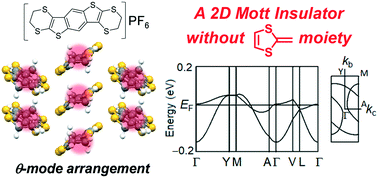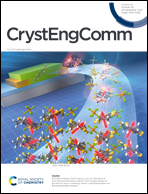Two-dimensional radical–cationic Mott insulator based on an electron donor containing neither a tetrathiafulvalene nor tetrathiapentalene skeleton†
Abstract
We report the structure and physical properties of a new radical–cationic Mott insulator θ-(BEDT-BDT)PF6 (BEDT-BDT: benzo[1,2-g:4,5-g′]bis(thieno[2,3-b][1,4]dithiin)). The crystal structure belongs to a monoclinic system with a 1 : 1 donor/anion ratio. Based on this composition, the salt is considered a half-filled Mott insulator, in which the BEDT-BDT molecules form a θ mode arrangement. Owing to the strong electron correlation, the temperature dependence of the resistivity exhibits semiconducting behaviour. The static magnetic susceptibility first follows the Curie–Weiss law down to 15 K, but then follows the two-dimensional (2D) triangular Heisenberg model with J = 7.5 K below 15 K. Even at 2 K, this salt is paramagnetic and no magnetic order is formed. The tight-binding band calculation reveals a 2D Fermi surface. It is remarkable that θ-(BEDT-BDT)PF6 forms a 2D electronic structure without any 1,3-dithiol-2-ylidene units, unlike tetrathiafulvalene and tetrathiapentalene donors.



 Please wait while we load your content...
Please wait while we load your content...